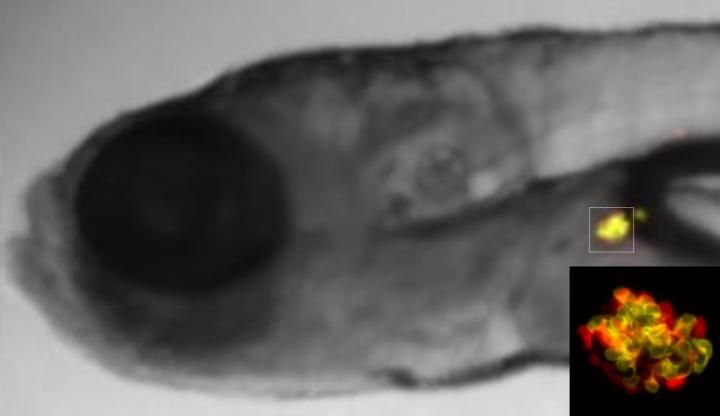Scientists report success using zebrafish embryos to identify potential new diabetes drugs
New form of high throughput screening could significantly shorten drug discovery for many diseases
In experiments with 500,000 genetically engineered zebrafish embryos, Johns Hopkins scientists report they have developed a potentially better and more accurate way to screen for useful drugs, and they have used it to identify 24 drug candidates that increase the number of insulin-producing cells in the pancreas.

The pancreatic beta cells of a specially bred zebrafish glow yellow to indicate the production of insulin. The pancreatic cells not responsible for producing insulin glow red.
Johns Hopkins Medicine
The novel fish embryo technique, which the researchers say may yield new treatments for diabetes and potentially speed new drug discoveries for other diseases, is described in eLife. "More studies need to be done, but we think there's potentially no limit on the diseases this screening technique could be applied to other than the human imagination," says Jeffrey Mumm, Ph.D., associate professor of ophthalmology at the Johns Hopkins Wilmer Eye Institute and McKusick-Nathans Institute of Genetic Medicine at the Johns Hopkins University School of Medicine.
Using standard genetic engineering technology, the researchers bred zebrafish in which pancreatic beta cells that produce insulin glowed yellow, and other pancreatic cells not responsible for producing insulin glowed red. The scientists then placed embryos from the modified fish in microtiter plate wells and tested thousands of compounds from a Johns Hopkins library of drugs, most of which were already approved for human use. Overall, each compound was screened at six different concentrations. Computer programs automatically monitored the effects on the embryos by "looking" for differences in the amount of yellow glow, which signified an increase in beta cell number.
After evaluating more than 500,000 zebrafish embryos, the researchers identified 24 compounds that effectively increased beta cell number in these animals, Mumm says. Besides identifying new drug candidates, the research also identified biological pathways not previously known to have an effect on beta cell production. For example, some of the newly identified drugs appeared to increase beta cell production through a pathway involving serotonin, a chemical better known for transmitting signals in the brain.
Most read news
Organizations
Other news from the department science

Get the life science industry in your inbox
By submitting this form you agree that LUMITOS AG will send you the newsletter(s) selected above by email. Your data will not be passed on to third parties. Your data will be stored and processed in accordance with our data protection regulations. LUMITOS may contact you by email for the purpose of advertising or market and opinion surveys. You can revoke your consent at any time without giving reasons to LUMITOS AG, Ernst-Augustin-Str. 2, 12489 Berlin, Germany or by e-mail at revoke@lumitos.com with effect for the future. In addition, each email contains a link to unsubscribe from the corresponding newsletter.






















































